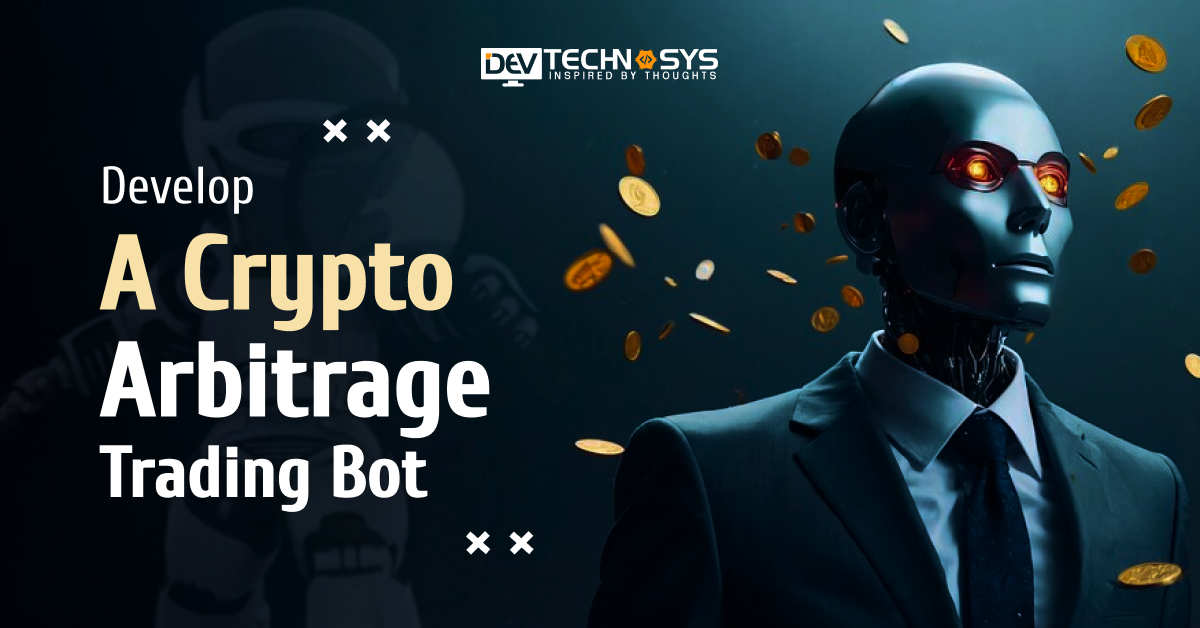Ever wonder if there’s a way to make money with cryptocurrency that doesn’t involve forecasting massive price changes? This is where crypto arbitrage comes in. In this strategy, you take advantage of the fact that the price of the same object can be different on different exchanges.
For example, if Bitcoin is trading at $30,000 on Exchange A and $30,200 on Exchange B, a smart bot can buy low and sell high, locking in a risk-free profit. With over 600 cryptocurrency exchanges worldwide and digital assets often fluctuating by 2–5% across platforms, the opportunities are real and measurable.
But to truly capitalize on this, speed, accuracy, and automation are key; that’s where a crypto arbitrage trading bot development comes in. In this blog, we’ll explore how businesses can develop a Crypto Arbitrage Trading Bot to identify and execute profitable trades consistently.
If you’re a fintech startup, crypto exchange, or investor group looking to gain an edge, this guide is your blueprint to smarter, faster crypto trading.
So, let’s begin!
What is a Crypto Arbitrage Trading Bot?
A crypto arbitrage trading bot is a software program that purchases and sells cryptocurrencies on multiple markets constantly in order to make money. It looks for price differences between exchanges, for example, Bitcoin might be cheaper on one site and more expensive on another.
The bot quickly buys where the price is low and sells where the price is high, earning small profits from each trade. Crypto trading bot development solutions work much faster than a person because prices can change very quickly. People use these bots to try and make steady profits without having to watch the market all the time.
How Does a Crypto Arbitrage Bot Work?
Crypto trading bot development helps people make money by using the fact that the price of the same cryptocurrency can be different on different platforms to their advantage. Clearly explained, this is how it works:
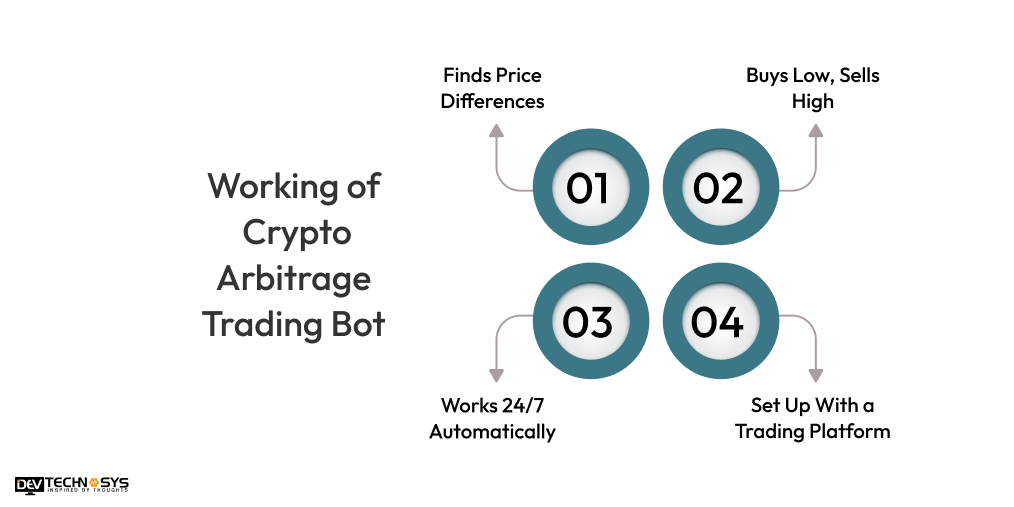
1. Finds Price Differences
Crypto prices can vary slightly between exchanges. A bot monitors multiple exchanges like Binance, Coinbase, or Kraken in real time to spot these price gaps. The bot can spot a chance, like if Bitcoin is worth $30,000 on one market but $30,200 on another.
2. Buys Low, Sells High
When the bot sees a price difference that makes money, it gets the cryptocurrency when it is cheaper and sells it when it is more expensive. This happens within seconds with crypto wallet development, so users don’t need to act manually; the bot does all the trading automatically.
3. Works 24/7 Automatically
Crypto markets never sleep. The cryptocurrency arbitrage bot runs nonstop, even when you’re sleeping, watching for profitable trades. It doesn’t panic or get greedy, it just follows the logic it was programmed with.
4. Set Up With a Trading Platform
Users connect the bot to their crypto exchange accounts using secure API keys. Most bots have user-friendly dashboards where you set your rules, limits, and preferred exchanges. After setup, the bot handles the trading while you monitor performance.
4 Major Types of Crypto Arbitrage Bots
Crypto arbitrage bots are automated tools designed to exploit price differences between different cryptocurrency exchanges. Here are the main types of these bots:
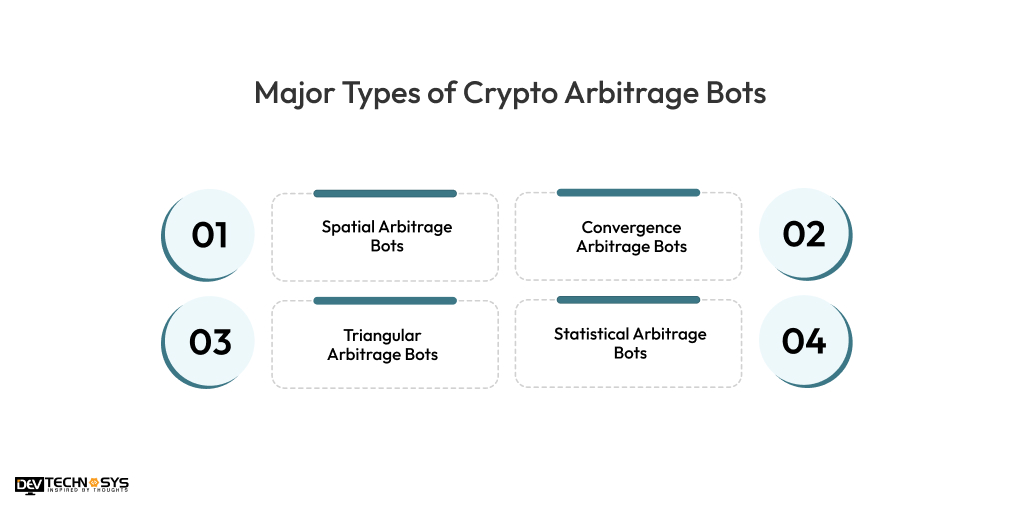
1. Spatial Arbitrage Bots
Spatial arbitrage bots focus on cost differences between two or more exchanges. This person buys a coin when it’s cheap and then sells it when it’s more expensive. This type of bot requires quick execution because the price gap may close quickly.
2. Convergence Arbitrage Bots
These digital asset arbitrage systems exploit price convergence in markets. When there is a difference in price between the futures and spot markets, the bot can make a profit by trading in both, expecting the prices to converge. If you are planning to develop a crypto arbitrage trading bot, then consult with a chatbot software development company.
3. Triangular Arbitrage Bots
These bots take advantage of the fact that three different currencies on the same market have different prices. The arbitrage trading bot crypto buys and sells different cryptocurrency pairs in a sequence that results in a profit.
Triangular arbitrage is more complex than spatial arbitrage, as it involves converting one cryptocurrency into another, then into a third one, before finally converting it back to the original currency.
4. Statistical Arbitrage Bots
Statistical arbitrage bots use complex blockchain arbitrage algorithms and market data to predict short-term price movements. It is the job of these bots to find trends in the market and trade based on those patterns. Unlike the previous types, statistical arbitrage doesn’t rely on immediate price differences but on market behavior over time.
Why Use a Crypto Arbitrage Trading Bot?
Coin arbitrage trading involves taking advantage of price differences between different cryptocurrency platforms. There are times when this process needs to be done quickly and correctly, which is where a crypto market neutral bot comes in.
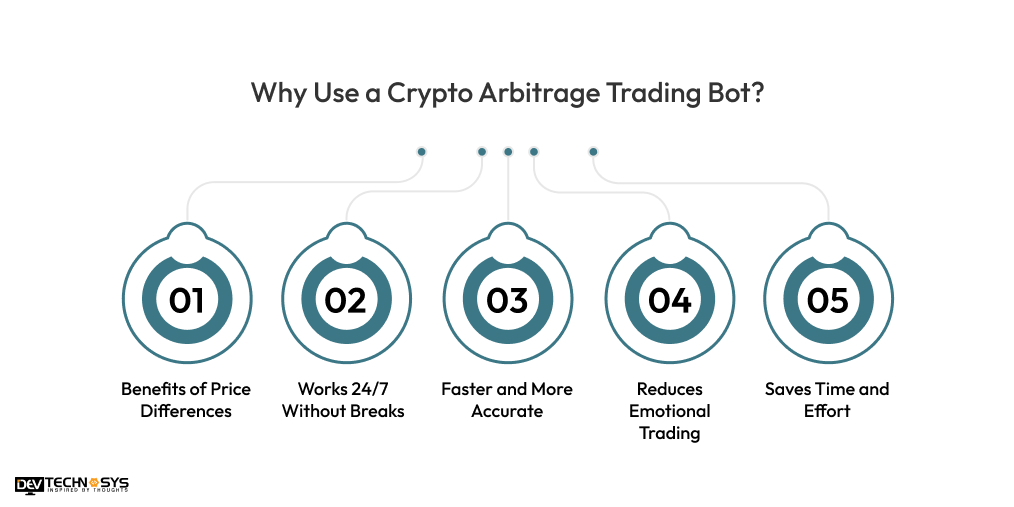
1. Takes Benefits of Price Differences
Crypto prices can differ from one to another. For example, Bitcoin might be $30,000 on one exchange and $30,300 on another. A cryptocurrency development services provider spots these differences and quickly buys from the cheaper exchange and sells on the more expensive one. This helps traders make profits from small price gaps, without doing it manually.
2. Works 24/7 Without Breaks
Unlike humans, arbitrage trading bot crypto don’t sleep. Cryptocurrency markets are open all day, every day, even on weekends and holidays. A crypto arbitrage bot works around the clock, monitoring markets and trading whenever opportunities appear. This gives traders a better chance of catching profitable trades at any time of day or night.
3. Faster and More Accurate
Speed matters a lot in arbitrage. Price gaps may only last a few seconds. Crypto arbitrage software can look at hundreds of prices and make deals in milliseconds, which is a lot faster than a person could do. This fast action helps traders take advantage of short-term opportunities that would otherwise be missed.
4. Reduces Emotional Trading
Many people lose money in crypto trading because of emotions like fear or greed. An arbitrage trading bot crypto follows a programmed strategy and doesn’t get nervous or overconfident. This removes emotional decision-making and helps keep trading more consistent and logical.
5. Saves Time and Effort
Manually checking multiple exchanges all day is time-consuming and exhausting. A crypto arbitrage bot does all the heavy lifting. Once set up, it runs on its own, saving traders hours of research and trading work every day.
Steps To Build a Crypto Arbitrage Trading Bot
It can be fun and possibly profitable to make a crypto arbitrage trading bot. The bot finds price differences between markets and makes deals to take advantage of them. To help you get started, here’s a breakdown of the key steps involved in developing such a bot.
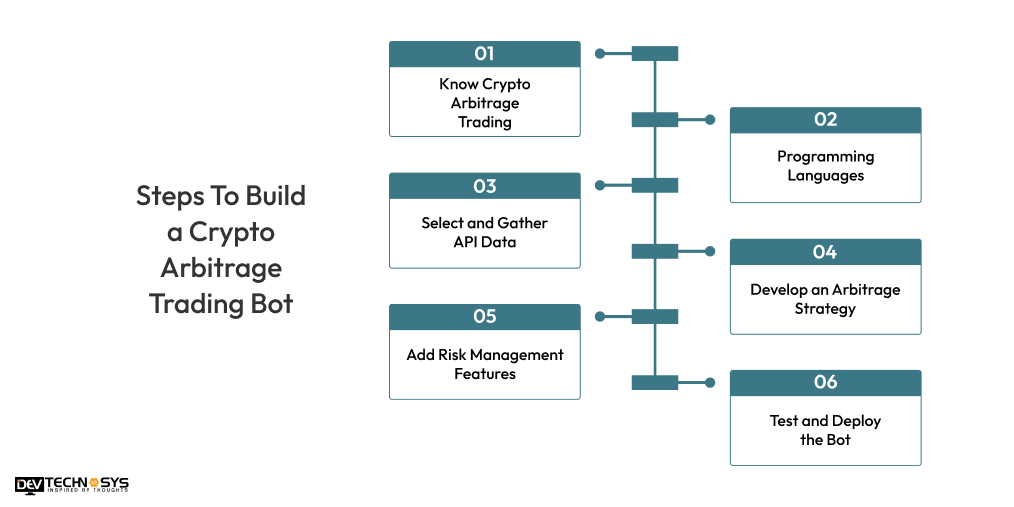
1. Know Crypto Arbitrage Trading
Knowing what an arbitrage trade crypto bot is is important before you start building one. It’s simply the act of profiting from the fact that the price of the same coin on different exchanges is not the same.
Some traders buy cryptocurrency at a lower price on one market and sell it at a higher price on another. This lets them make money. A crypto arbitrage trading bot development company needs to grasp this concept thoroughly to create a crypto Arbitrage Bot.
This can automatically identify and capitalize on these price discrepancies in real-time. Understanding the risks and rewards is crucial to build a crypto arbitrage bot.
2. Select Programming Languages
You need to choose the right computer language and tools before you can develop a crypto arbitrage trading bot. Crypto arbitrage bot Python is a popular choice because of its simplicity, large community support, and powerful libraries, which make it easier to work with APIs from various crypto exchanges.
Other programming languages like JavaScript or C++ can also be used, but a crypto trading bot development company should focus on a language they are comfortable with and that supports fast execution. Additionally, integrating API keys from various exchanges will be a critical part of your bot’s design, so understanding how to handle APIs is a must.
3. Select and Gather API Data
Once the programming tools are set, the next step for the crypto arbitrage trading bot development services team is to select the crypto exchanges where the bot will operate. Popular exchanges include Binance, Kraken, and Coinbase.
You’ll need to obtain API keys from these exchanges to allow your bot to interact with their cryptocurrency arbitrage software. Each exchange will have different rules and endpoints for trading, so developers need to familiarize themselves with each exchange’s API documentation.
It’s also important to monitor the fees for each exchange in AI crypto arbitrage trading bot development clone, as they can impact the profitability of arbitrage trades.
4. Develop an Arbitrage Strategy
Now that you have the tools and exchanges ready, the next step is to develop the actual arbitrage strategy for the bot. This includes coding the logic that will identify price discrepancies between exchanges.
A crypto trading bot development services team must create algorithms that can monitor multiple exchanges simultaneously, track real-time prices, and calculate the potential profit for each arbitrage opportunity.
The bot should also account for transaction fees, withdrawal fees, and any latency in executing trades to avoid costly mistakes. This step is crucial in ensuring the bot’s efficiency and profitability.
5. Add Risk Management Features
Even though arbitrage trading in cryptocurrency offers opportunities, it’s not without risks. The crypto arbitrage trading bot development company must implement risk management features into the trading bot to mitigate potential losses.
This AI crypto arbitrage bot development includes setting limits on the amount to trade, introducing stop-loss features, and ensuring that the bot only executes trades when a certain profit threshold is met.
The crypto exchange platform development company should also consider the speed of the bot crypto arbitrage, as crypto markets can move quickly, and delays can turn a profitable trade into a loss. Testing the bot in a risk-free environment can help fine-tune the risk management strategies before real trading.
6. Test and Deploy the Bot
Once your crypto arbitrage trading bot has been developed and fine-tuned, the final step is to test and deploy it. Before testing the code in the real world, it should be run in a simulation to make sure it works as planned.
In different market situations, this means testing for speed, accuracy, and dependability. After thorough testing, the arbitrage trading bot crypto can be deployed with real money, but developers should start with a small amount to minimize risk.
Key Features of Crypto Arbitrage Trading Bot
When developing an arbitrage crypto trading bot, there are several key features you can integrate into your arbitrage software crypto to enhance its performance, usability, and functionality. Here are some features you can consider:
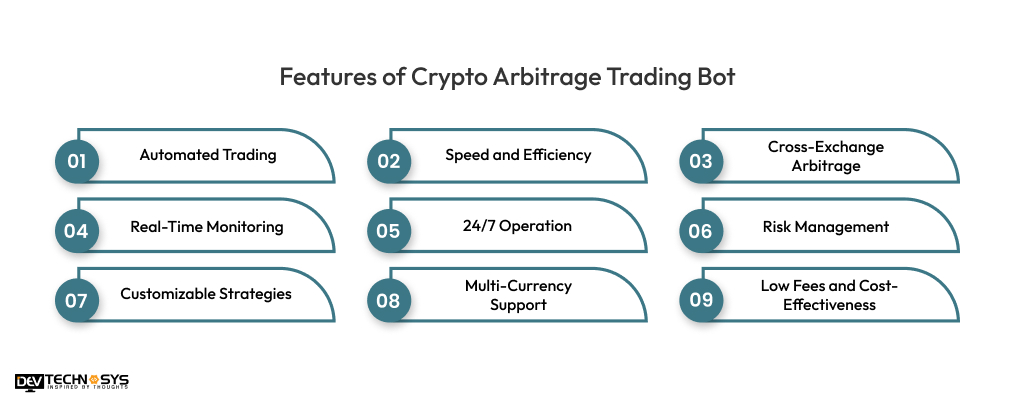
1. Automated Trading
A crypto arbitrage trading bot operates automatically, executing trades based on pre-set strategies. This automated crypto arbitrage trader allows users to take advantage of price differences between various exchanges without needing to be constantly online.
2. Speed and Efficiency
Crypto markets can change rapidly, and a trading bot reacts instantly to price changes. It can execute trades within milliseconds, ensuring you don’t miss profitable opportunities.
3. Cross-Exchange Arbitrage
When you use the best arbitrage trading apps, they check multiple coin exchanges for price differences. When a cryptocurrency is cheaper on one exchange and more expensive on another, the cross-exchange arbitrage bot buys from the cheaper exchange and sells at the higher price, securing a profit.
4. Real-Time Monitoring
The arbitrage signal bot continuously monitors price data from different exchanges, ensuring it can spot arbitrage opportunities in real-time. This makes it less likely that you’ll miss out on income.
5. 24/7 Operation
Unlike humans, an arbitrage software crypto doesn’t need to rest. The AI in crypto arbitrage trading bot development runs 24/7, taking advantage of arbitrage opportunities even when you’re asleep or away.
6. Risk Management
Advanced defi arbitrage bots have risk management tools like stop-loss orders that make sure you lose as little money as possible if the market goes against you.
7. Customizable Strategies
Users can change the bot’s trading methods to fit their trading style, risk tolerance, and goals. Some cryptocurrency arbitrage trading bots even allow backtesting, letting you test strategies on historical data.
8. Multi-Currency Support
Many crypto arbitrage software support a wide range of cryptocurrencies. The custom software development solution allows users to exploit arbitrage opportunities across various coins and tokens.
9. Low Fees and Cost-Effectiveness
With automated trading, the need for a human trader is removed, reducing costs. The defi arbitrage bot also ensures that trades are executed in a way that minimizes transaction fees.
Most Popular Crypto Arbitrage Trading Bots in 2025
If you are looking for the best crypto arbitrage trading bots? Look no further. If yes, then you should check out the following top crypto arbitrage bots alternatives.
Best Crypto Arbitrage Trading Bots |
Available Platforms |
Downloads |
Ratings |
| Cryptohopper | Android | iOS | 100K+ | 3.4 |
| Pionex | Android | iOS | 1M+ | 3.9 |
| 3Commas | Android | iOS | 50K+ | 4.3 |
| Binance | Android | iOS | 10M+ | 4.5 |
| TradeSanta | Android | iOS | 50K+ | 3.6 |
How Much Does It Cost To Build A Crypto Arbitrage Trading Bot?
The cost to develop a crypto arbitrage trading bot ranges between $8000 – $25000. However, the actual crypto arbitrage trading bot development cost can vary depending on your business needs. For example, if you want a basic crypto bot, then it may cost less, while a customised bot can increase the cost.
So, it is vital to first consult with a cryptocurrency development company, then plan a budget setup and make a strategy. Let’s now go through the factors affecting the cost to build a crypto arbitrage trading bot.
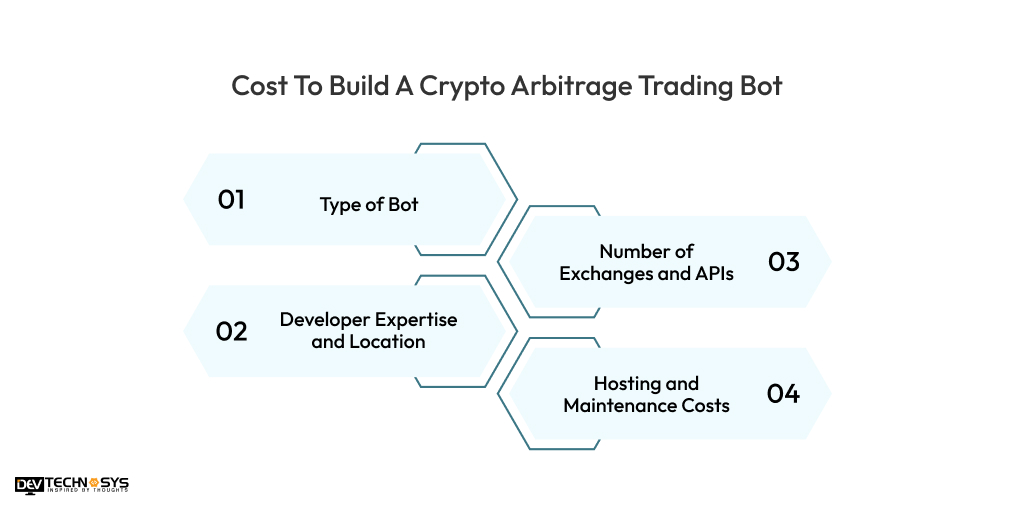
1. Type of Bot
A basic bot that just looks for price differences between a couple of exchanges and executes trades can be relatively cheap, maybe a few hundred to a couple thousand dollars. But if you want an advanced bot that uses smart algorithms, AI, or machine learning development, and supports multiple exchanges with fast reaction times, the AI crypto arbitrage trading bot development cost can go up to $8,000 or more. The more features you want, the more it’ll cost.
Type of Bot |
Estimated Cost |
| Basic Cross-Exchange Bot | $8,000 – $12,000 |
| Advanced Cross-Exchange Bot | $12,000 – $18,000 |
| Customizable Arbitrage Bot | $18,000 – $25,000+ |
| AI-Powered Arbitrage Bot | $25,000+ |
2. Developer Expertise and Location
Hiring an experienced decentralized exchange development company affects the price a lot. A freelancer from the U.S. or Western Europe may charge high, while someone from regions like South Asia or Eastern Europe might charge less. If you’re building a custom bot, development time can take several weeks, which adds up quickly.
Developer Location |
Estimated Hourly Rate |
| India | $15 – $30 |
| Eastern Europe | $40 – $80 |
| South America | $30 – $70 |
| North America/Western Europe | $80 – $150+ |
3. Number of Exchanges and APIs
The more exchanges your bot needs to connect to, the more complex it becomes. Every exchange has its own API (a way for the bot to talk to the exchange), and integrating each one takes time. Adding support for 5–10 exchanges instead of just one or two could significantly increase the cost to develop a crypto arbitrage bot due to more coding, testing, and maintenance.
Feature/Component |
Estimated Cost |
| Market Research & Strategy | $500 – $2,000 |
| Bot Design & Architecture | $1,000 – $3,000 |
| Development & Coding (Core Logic) | $4,000 – $15,000 |
| API Integration & Management | $1,000 – $4,000 per exchange |
| Backtesting & Simulation | $500 – $2,000 |
| Security Implementation | $500 – $1,500 |
4. Hosting and Maintenance Costs
Once the bot is built, it needs to run 24/7. You’ll need a reliable server or cloud hosting, which might be crypto arbitrage trading bot development cost around $20–$120/month. Also, bots often need updates when exchange APIs change or new bugs appear. So, ongoing maintenance is another cost to keep in mind.
Cost Category |
Estimated Monthly Cost |
| Hosting (VPS/Server) | $100 – $500+ |
| API Subscription Fees | $50 – $500+ per exchange |
| Data Feed Services (Optional but Recommended) | $100 – $400+ |
| Maintenance & Updates | $200 – $1000+ |
| Security Costs (Ongoing) | $50 – $300+ |
How To Monetize Your Crypto Arbitrage Trading Bot?
Making money with your arbitrage crypto trading bot means using its ability to profit from price differences between different cryptocurrency platforms. How to do it:
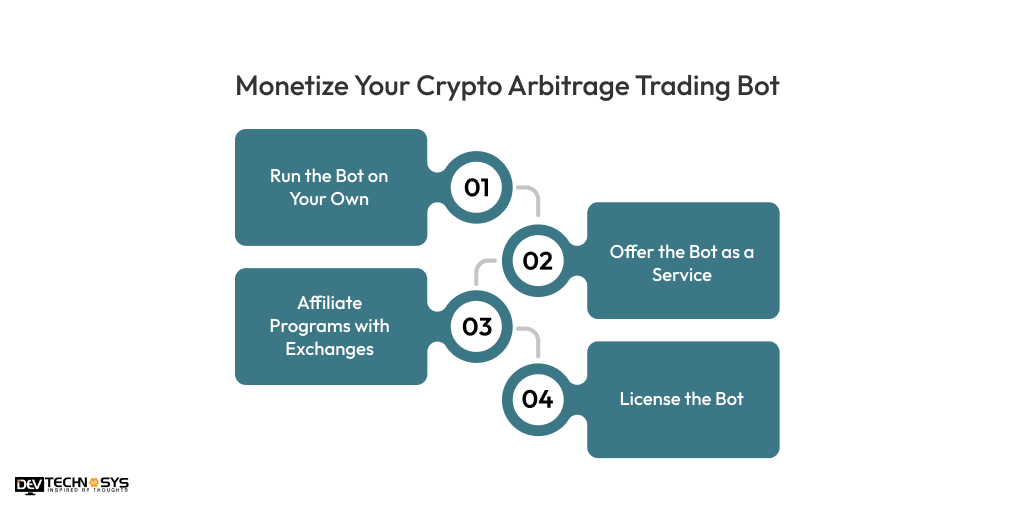
1. Run the Bot on Your Own
If you have a solid trading bot and access to capital, you can run it yourself. You can tell your bot to buy cryptocurrency when it’s cheap on one market and sell it when it’s more expensive on another. Keep the profits from each successful trade.
2. Offer the Bot as a Service
If you’re skilled in creating and running arbitrage bots, you can offer your bot as a service. Some people pay a one-time or monthly fee if they want to use your bot to trade on their own.
3. Affiliate Programs with Exchanges
Partner with an automated crypto trading bot development team that offers affiliate programs. You can refer users to those exchanges using your bot, earning commissions on the trades or deposits they make through your referral links.
4. License the Bot
License your trading bot to other traders or companies. For a set fee, they get access to use your bot for a specified time, and you earn passive income without needing to trade actively yourself.
Final Thoughts
Crypto arbitrage trading bot development opens the door to exciting profit opportunities with the right strategy, tools, and mindset. While automation can streamline trades, staying updated and refining your bot is key to long-term success.
Whether you’re just exploring or ready to scale, partnering with a skilled chatbot development services provider can accelerate your journey. They bring the technical know-how to turn your trading ideas into smart, working solutions. Start small, stay sharp, and keep learning!
Frequently Asked Questions
1. How Long Does It Take To Build A Crypto Arbitrage Trading Bot?
The estimated time to develop a crypto arbitrage trading bot can take 2 – 5 months. However, the project requirements affect the overall development time.
2. How Much Does It Cost To Create A Crypto Arbitrage Trading Bot?
The cost to make a crypto arbitrage trading bot can lie between $8,000 – $25,000 or more. It is vital to know that factors like complexity, functions, design, and so on affect the cost.
3. How To Build A Crypto Arbitrage Bot?
- Learn the basics of crypto markets
- Choose reliable exchanges
- Use APIs for data access
- Identify arbitrage opportunities
- Write a bot in Python/Node.js
- Automate trade execution
- Monitor performance regularly
4. Is There a Free AI Trading Bot?
Yes, there are free AI trading bots like Pionex, Alpaca, and Kryll offering basic features. However, advanced tools, strategies, and support often require paid subscriptions or commissions.
5. How is a Crypto Arbitrage Bot Different from a Crypto Trading Bot?
A crypto arbitrage bot exploits price differences across exchanges, while a crypto trading bot executes strategies like trend following or scalping within one exchange to profit from market movements.
